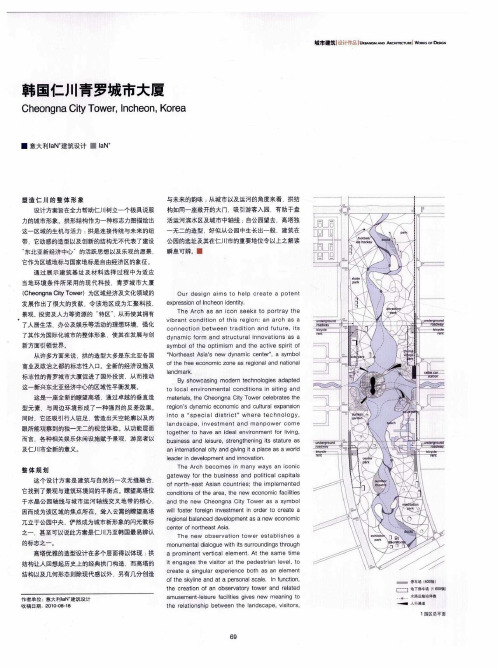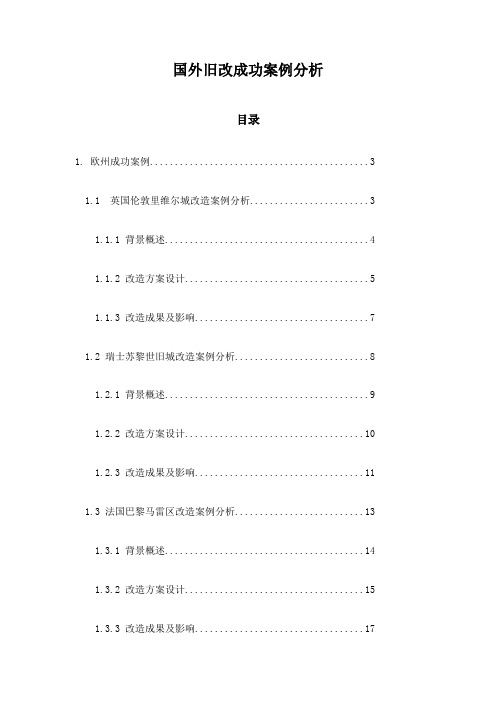Asymptome_韩国.首尔龙山区国际商务区城市设计(国际竞标)
- 格式:pdf
- 大小:4.01 MB
- 文档页数:33

2019大体量办公——爱茉莉太平洋集团总部建筑中心项目概况Contents 建筑设计设计理念借鉴参考01020304Part One项目概况amorepacific headquarters.•David Chipperfield建筑师事务设计了韩国美容巨头爱茉莉太平洋集团的总部大楼,这座建筑呈立方体,上面点缀着充满树木和水池的空腔•项目总体量216000㎡,是超大规模的建筑单深体圳办公中,原坐落建于筑韩国中首心尔,于2017年完成本案城市中心区域龙山站商务区江北江南韩国首尔市区地图•项目位于韩国首尔江北区域,距离城市中心区域约5公里,位于龙山商务区的核心地带•临近汉江,多条跨江公路可与对岸江南地区连接,地理位置优越待开发区域本案•项目临近龙山高铁站(同时为地铁站),龙山站为首尔最大的高铁站,建成以后使周边大量办公产业的聚集地•项目处于轨道商务区的北侧,西侧为发展中的新城区,东侧为历史保留街区,承接了新与旧的过渡历史街区Part TWO设计理念Write down something here.点击此处添加标题高容积率空间舒适度与周边的关系建筑形态深圳中原建筑中••项目总体量近22万,在有限的占地上实现众多更能的组合对设计带来了巨大的挑战•项目最终选取了“回”字型的建筑形态,利用内部天井获取更多的开放空间心平面的深确立圳使得中建原筑庞建大的筑体中量从心周边的建筑群中脱颖而出•设计选取了大型的独栋方形建筑体量,避免了多栋密集体量之间的视线干扰•方形体量的中部设立中空部分,作为建筑的中庭空间,为部门空间带来更好的采光和视野•建筑底部设置四面的骑楼空间,为办公人员获取更多的室外活动场地•首层向四面八方开放,直接通向建筑的中心,中庭不仅是核心区,也是艺术装置、音乐会、讲座等其他文化活动的主要活动场所•建筑分别在五层,十层以及十六层分别朝三个方向设置空中花园,以获得更好的景观与采光,同时削弱过大的建筑体量造成的压迫感•空中花园尽可能规避视线干扰,保证每一个空间享受较好的景观朝向Part Three建筑方案Write down something here.点击此处添加标题•立面采用双层设计,在里层建筑立面上利用百叶窗来遮阳,使苍白的立面拥有柔和而朦胧的感觉,不同朝向采用不同的角度,以保证内部空间的舒适度。

韩国首尔龙山国际商务中心大楼
项目名称:首尔龙山国际商务中心大楼(The Blade )
建筑师:多米尼克·佩罗建筑事务所
项目地点:韩国,首尔
项目时间:2016年
龙山国际商务中心的这一“刀锋”塔的设计者是多米尼克佩罗建筑事务所。
这不是一个正方形或圆形建筑,而是一个菱形棱镜,以样的排列方式,根据角的方法,使得它看起来是不同的。
这一大厦外观独特,修长的外形如同刀锋一样,给人以压迫的锋利感。
龙山国际商务中心占地587,000平方米,从2011年9月-11月,韩国大财团Dreamhub就邀请了15所国际知名建筑事务所设计这一大楼。
多米尼克·佩罗是唯一一个受邀参加方案设计的法国建筑事务所,之前事务所因涉及梨花女子大学而得到认可。
这一“刀锋”它如同一个图腾一样的标志伫立在商务中心区内,当之无愧地成为此区域的一个地标性建筑。
建筑外观的设计具有极强的通透感,使位于其中的人们可以尽情感受首尔当地的自然风光。
夜晚降临,霓虹乍亮,整个大厦水晶般通透的外观映衬在暮色之中,如同一块被精心切割的水晶石。


国外旧改成功案例分析目录1. 欧州成功案例 (3)1.1 英国伦敦里维尔城改造案例分析 (3)1.1.1 背景概述 (4)1.1.2 改造方案设计 (5)1.1.3 改造成果及影响 (7)1.2 瑞士苏黎世旧城改造案例分析 (8)1.2.1 背景概述 (9)1.2.2 改造方案设计 (10)1.2.3 改造成果及影响 (11)1.3 法国巴黎马雷区改造案例分析 (13)1.3.1 背景概述 (14)1.3.2 改造方案设计 (15)1.3.3 改造成果及影响 (17)2. 美洲成功案例 (18)2.1 美国纽约下城酒吧街改造案例分析 (19)2.1.1 背景概述 (21)2.1.2 改造方案设计 (21)2.1.3 改造成果及影响 (23)2.2 巴西里约热内卢老城改造案例分析 (24)2.2.1 背景概述 (26)2.2.2 改造方案设计 (27)2.2.3 改造成果及影响 (28)2.3 墨西哥墨西哥城历史城中心改造案例分析 (29)2.3.1 背景概述 (30)2.3.2 改造方案设计 (32)2.3.3 改造成果及影响 (33)3. 亚洲成功案例 (34)3.1 韩国首尔兴京地区改造案例分析 (36)3.1.1 背景概述 (38)3.1.2 改造方案设计 (39)3.1.3 改造成果及影响 (40)3.2 新加坡莱佛士初创区改造案例分析 (41)3.2.1 背景概述 (43)3.2.2 改造方案设计 (44)3.2.3 改造成果及影响 (45)3.3 日本东京神田地区改造案例分析 (46)3.3.1 背景概述 (48)3.3.2 改造方案设计 (49)3.3.3 改造成果及影响 (50)4. 总结与展望 (52)4.1 国外旧改成功经验总结 (53)4.2 对中国旧改的启示 (54)4.3 未来发展展望 (55)1. 欧州成功案例汉堡市位于德国北部,是德国第二大城市和最重要的海港和最大的外贸中心、德国第二金融中心,同时是德国北部的经济和文化大都市,有着“世界桥城”的美称。


S-Trenue 大厦坐落在韩国首尔的汝矣岛上,它是一栋商业、办公、居住的综合体建筑。
它的确立反映了建筑师面对全球化和城市化问题的思考和应对策略,同时也是MASS 事务所矩阵系列建筑中的一个代表性作品。
韩国首尔在过去的50年中,城市人口所占的比例从20%上升至82%,居住在公寓中的人口比例从30%上升到70%。
然而要在这片只占全国面积1/160的土地上,安排这个国家近四分之一人口的居住和生活确乎是一个很大的难题。
如今在汉江两岸,伫立着一片片略显陈旧的高层公寓,那是自上世纪60、70年代以来随着首尔人口的极度膨胀而兴建的。
这些建筑都是大批量工业化制造的产物,造型雷同,色彩的搭配也完全一致,甚至每套公寓的装修都一模一样。
全球化的趋同力量,使首尔一度成为毫无个性的城市,人们唯一能够据以确认自己所在地点的,只能是写在大楼上的号码和标幅。
然而最近的十年间,一种多元化的力量,开始在包括首尔的世界各大都市盛行。
人们热衷于建造各种个性风格的高层地标性建筑。
大多数韩国建筑师也只将设计的着眼点放在建筑的外观和立面风格上,从巴洛克到极少主义,都只是表面的、肤浅的模仿流行。
面对上述问题,MASS 事务所的创始人Minsuk Cho 主张由表及里的对建筑的剖面、空间、体量做深入的探讨和创新,因为建筑空间才是对社会更有意义的因素。
他采用了一种类型学的研究方法,将建筑视为各个不同功能单元的集合体,将建筑的剖面视为大量功能单元聚合在一起的矩阵图形。
这样,传统的建筑设计从竖向上看,只是把相同的标准层平面一层一层地堆叠起来,缺乏剖面设计。
而矩阵思想的建筑设计,则是要突破建项目名称:S-Trenue 大厦建筑设计:Mass Studies 建筑总面积:约4万m 建造时间:2006年8月– 2009年11月地下:7层地上:36层地下2-7层为停车库和设备用房地下1层-地上4层为商业用房,地上5层-36层为办公居住综合功能。
摄影:Kyungsub Shin 、Wan Soon Park 、Yong-Kwan Kim Matrix Architecture文:王丹 图片提供:Mass Studies 编辑:路然矩阵建筑01-总立面图02-S-Trenue 大厦 ©Wan Soon ParkA t t e n t i o n0101筑剖面和空间的均质化和单一化,从而为大面积、多功能、高密度的高层建筑创造一个多样性的、绿色生态的、具有城市风貌的空间环境。
以韩国首尔为中心的都市圈的城市建设的相关启示摘要:本文主要阐述韩国首都圈的规划建设、新城开发、综合交通体系和基础设施建设、住宅开发、生态环境保护等方面内容,以及对韩国首尔的城市建设及规划系统进行概括。
韩国首都首尔(Seoul,旧译“汉城”)地处朝鲜半岛中部,因位于汉江之北,古称“汉阳”。
14世纪末,朝鲜王朝定都汉阳后,改名为“汉城”。
1945年朝鲜半岛光复后,汉城的英文名字按韩国语固有词发音用SEOUL标记,意为“首都”。
2005年,在市政府推动下,汉城的中文译名由使用了600多年的“汉城”改为SEOUL的谐音“首尔”。
作为韩国首都,首尔是韩国政治、经济、文化和教育中心。
以首尔为中心的70km以内的首尔特别市、仁川直辖市、京畿道行政区及其下属的64个次级地方行政区,组成“首都圈”,总面积1.18万km2,仅占韩国总面积的12%,但韩国近5000万人口中的一半生活在“首都圈”内,韩国7成的国民生产总值也来自“首都圈”。
韩国首都圈的形成始于1960年代韩国工业化快速启动时期,1970年代中期初步形成,1990年代趋于成熟稳定。
在这40年的时间里,首都圈经历了中心集聚快速发展、中心限制稳定发展、中心扩散外围发展3个重要的发展阶段,城市发展水平不断提高、空间结构不断优化、城市化建设成果不断巩固,首都圈从首尔的一城独大发展到区域的整体崛起,从人口、产业等的中心集聚发展到区域均衡布局,同时,通过举办1988年奥运会和2002年世界杯,整个区域的市政、综合交通、生态环境等都大幅改善和提升。
到1990年代,首都圈的城市化率达96%,集中了全国约一半的人口。
韩国首都圈已成为东亚地区著名的超级大都市圈之一,是韩国区域经济的龙头、区域发展的楷模,在韩国的经济社会发展中占有十分重要的地位。
一、韩国首都圈的主要做法和经验借鉴韩国首都圈经过不断发展探索和创新实践,都市圈发展理念更为成熟,发展措施更加得力,首都圈的整体规划建设水平高、成效显著,许多经验做法值得我们学习借鉴。
韩国Gwanggyo权利中心设计Gwanggyo Power Centre by MVRDVDutch atchitects MVRDV have won a competition to design a city centre for Gwang gyo, a new town south of Seoul, Korea.荷兰建筑师MVRDV赢得了韩国首尔南部新城Gwanggyo城市中心设计。
The design consists of skinny, hill-shaped buildings that contain housing, offices, park ing, retail, leisure, and educational spaces. Although the concept plan is currently under re view for feasibility and cost estimations, if everything moves forward, Gwanggyo Power C entre will become a self-sustaining town of 77,000 inhabitants.该城市中心由数栋建筑组成,这些建筑可用于居住、办公、停车、零售、休闲以及教育等。
虽然目前这一概念设计因可行性、建设成本评估等需要复审,但如果事情顺利的话,G wanggyo权利中心将成为一座拥有 77,000 居民的独立新城。
“This diverse program has different needs for phasing, positioning and size,”say the architects. “To facilitate this all elements are designed as rings. By pushing these rings o utwards, every part of the program receives a terrace for outdoor life.”The Power Centre is remarkably green, but that’s all for a purpose. The design is i ntended to mimic and link to the lake and hills (and the natural environment surrounding the site). It was conceived in rings because the town has different needs for phasing, posi tioning, and size. Every structure has a terrace with plantations for outdoor life. The plant ations are fed by a floor-to-floor circulation system that stores water for irrigation. The en d result is a vertical park that reduces energy and water usage.The towers each feature prominent voids that act as atriums, lobbies, and plazas and also provide light and ventilation. Gwanggyo Power Centre, as currently planned, anticipates having over 2 million square feet for housing, 2 million square feet for parking, 500 t housand square feet for offices, and over 2 million square feet for culture, retail, leisure, and education. That’s a development comprising ~6.5 million square feet of space.Completion of the development is envisioned for 2011.The following information is from MVRDV:–MVRDV wins Gwanggyo City Centre Competition, near Seoul, South KoreaThe Daewoo Consortium and the municipality of Gwanggyo announced the MVRDV concept design for a dense city centre winner of the developer’s competition for the futu re new town of Gwanggyo, located 35km south of the Korean capital Seoul. The plan co nsists of a series of overgrown hill shaped buildings with great programmatic diversity, ai ming for high urban density and encouragement of further developments around this so-cal led ‘Power Centre’, one of the envisioned two centre’s of the future new town.Since the beginning of the millennium local nodes with a high density concentration of mixed program are used in Korean town planning. These nodes consist of a mix of pu blic, retail, culture, housing, offices and leisure generating life in new metropolitan areas a nd encouraging further developments around them: the Power Centre strategy. The Gwang gyo Power Centre will consist of 200,000m2 housing, 48,000m2 offices, 200,000m2 mix o f culture, retail, leisure and education and 200,000m2 parking.This diverse program has different needs for phasing, positioning and size. To facilitat e this all elements are designed as rings. By pushing these rings outwards, every part of t he program receives a terrace for outdoor life. Plantations around the terraces with a floor to floor circulation system store water and irrigate the plants. The roofs of these hills and the terraces are planted with box hedges creating a strong, recognizable, cohesive park. This vertical park will improve the climate and ventilation, reduce energy and water usage. As a result a series of overgrown green ‘hills’appear in the landscape.The site is surrounded by a beautiful lake and forested hills, the design aims to creat e a landscape on top of the new program that enlarges the green qualities and that links t he surrounding parks by turning the site into a park.The shifting of the floors causes as a counter effect hollow cores that form large atri ums. They serve as lobbies for the housing and offices, plazas for the shopping center an d halls for the museum and leisure functions. In each tower a number of voids connect t o the atrium providing for light and ventilation and creating semi-public spaces. On the lo wer floors the atriums are connected through a series of public spaces on various levels li nking the towers and serving the outdoor facilities of the culture, retail and leisure progra m. The Power Centre creates a dense urban program with a green regard.The concept plan is currently at the Gyeonggi provincial authority’s Urban Innovatio n Corporation for further development and feasibility study, the entire new town will be a self sufficient city of 77,000 inhabitants. The estimated budget and timeframe are still in the process of being established, completion is envisioned for 2011. A consortium lead b y Daewoo develops the project with local firm DA Group, which commissioned MVRDV to design the scheme. British firm Arup is involved as engineer.。